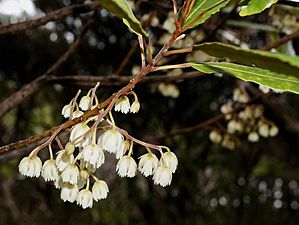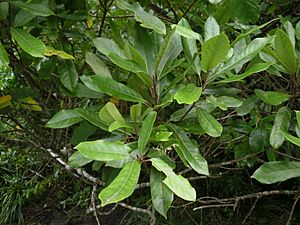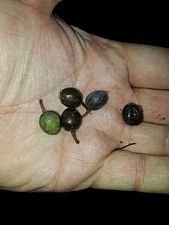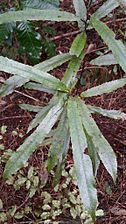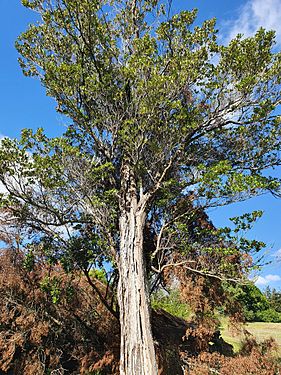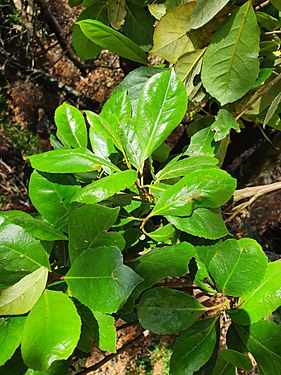Hinau facts for kids
Quick facts for kids Hinau |
|
|---|---|
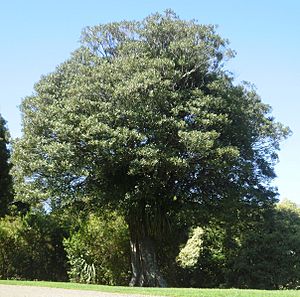 |
|
| Scientific classification | |
| Genus: |
Elaeocarpus
|
| Species: |
dentatus
|
| Varieties | |
|
|
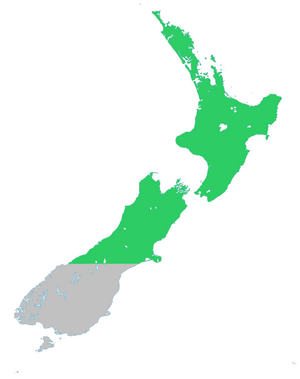 |
|
| Natural range of Hīnau | |
Elaeocarpus dentatus, commonly known as hinau (Maori: hīnau), is a native lowland forest tree of New Zealand. Other names in Māori for the tree are hangehange, pōkākā and whīnau.
A member of the family Elaeocarpaceae, it is found on both the North and South Islands of New Zealand, but not on Stewart Island. The leaves are dark green, with a toothed edge. On the underside of the leaf small domatia are present. Clusters of small white flowers are produced in spring, and in late summer the flowers form into a fleshy fruit.
It was officially first recorded for science by botanists Joseph Banks and Daniel Solander on 5 November 1769.
Contents
Description
Elaeocarpus dentatus is a tree which grows to around 18 m (59 ft.) tall and has a trunk of around 1 m (3.2 ft.) in diameter with greyish bark which roughens with age. It has leathery leaves which are 10–12 cm long and 2–3 cm wide. On top they are a dark green and an off-white colour below.
It flowers from October to February with flowers very similar to the lily of the valley extending off of 10–18 cm long racemes, each one bearing 8 - 10 flowers. The flowers (around 12mm in diameter) are white and droop down, connected to the Raceme by 1 cm long silky pedicels. They are made of 3 - 5 petals which are lobed at their tips and have long anthers which extend out on short filaments. The sepals are covered with many tiny hairs.
It fruits from December through to when it ripens in May. The fruit are purple-black egg-shaped drupes which are 12–18 mm long and 9 mm wide and are attractive to birds. It has 2-celled ovaries and a rugulose (wrinkly) endocarp. The drupes are very fleshy, the flesh making up 56% of the mass, and have a relatively low level of water at 66%. They have a mean mass of 1.05g and have the following compositional breakdown (after moisture is removed): 69.9% N.F.E (Soluble carbohydrates), 21.8% Crude Fiber, 3.4% Crude protein, 3.2% Ash, and 1.7% Lipid.
The hīnau is bisexual, meaning its flowers contain both the male (stamen) and female (carpel) parts, and has 15 pairs of chromosomes (2n = 30). It is very similar to Elaeocarpus hookerianus but can be distinguished by its larger leaves, flowers and fruit, and its lack of E. hookerianus's distinctive divaricating juvenile to sub-adult form.
The heartwood is dark brown and the sapwood is white, the heartwood, being heavy and strong, is used for making fence posts. It is, however, rarely milled because it is often hollow inside.
-
Hīnau drupes (fruit)
Ecology
The fruit are eaten (off the ground) by North Island brown kiwi (Apteryx mantelli) who use the seeds as grinding agents to help break down food in their gizzards. To Kākā on Kāpiti Island the drupes are an important food source especially in March and, for males, from March all the way until June. This is thought to be because of the different shaped mandible which females have as the fruit actually harden in the months following March, meaning the females are unable to break into them to get at the developing seed, the part that Kākā eat. They also rely heavily on Hīnau and Tawa to feed their young, both because of their prevalence on the island and their abundant crop of fruit. Weka (Gallirallus australis) eat the fruit which falls onto the ground and are thought to be very important dispersers after the extinction of many of New Zealand's other flightless birds. Hīnau seeds may also germinate better after the coat has been torn open and the Weka's gizzard might have a similar effect, though more research is needed. Kōkako eat both the leaves and fruit, though they make up a very small proportion of the bird's varied and complex diet. The extremely hard endocarp is thought to be for protection inside the digestive systems of large flightless birds who acted as another disperser by eating fallen fruit. It is also possible, however, that it is to balance the over-eating of their fruit by parrots, like the Kākā, who have been found digesting an average of 7.1 seeds per minute in March.' Kererū also eat the fruit and act as a disperser, though not to the degree Weka do.
In New Zealand forests the trunks of trees are crucial to flightless invertebrates who use them as a way to reach the canopy for food and breeding. One study which trapped these invertebrates coming up and down Hīnau trees found that the most prevalent species coming up were Springtails, followed by Wasps and ants, Spiders, Beetles and Weevils and Mites. Coming down the trunk the most common were the mites, making up 15%. Followed by larvae, springtails, and harvestmen.
Etymology
From the Latin "elaeocarpus" meaning olive-seed and "dentatus" meaning toothed.
Distribution
E. dentatus is endemic to New Zealand and found in both the North and South Islands down to South Westland and Christchurch on the east and west. It grows from sea level to 600 m (1970 ft.), essentially anywhere north of the latitude 43˚30'S.
Varieties
There is a variety called Elaeocarpus dentatus var. obovatus (Cheeseman) which is recognised by New Zealand Flora but not by Druce (1993). It is listed as a synonym of Elaeocarpus dentatus by both The Plant List and World Flora Online, which superseded it. It was mentioned in a Department of Conservation (New Zealand) Conservation Status Report published in 2017, under the heading: "Data Deficient."
This variety is, however, clearly very distinctive and has much wider leaves (5–7 long and 3–5 cm wide).
Cultivation
E. dentatus prefers a rich, moist soil in partial shade. To grow, press the seed well in and cover with 5mm of soil. It takes around 6 months to germinate and fresh fruit can be used.
In Māori culture
Mythology
In Māori mythology Māui discovers the origin of fire by stealing the nails of his grandmother Mahuika, the atua (God) of fire, extinguising each one. After realising that Māui had taken all of her fire she threw her last nail at him. It missed and landed first in the Rata (all species under NZ), Hīnau, Kahikatea, Rimu, Mataī, and Miro trees who rejected the fire. It then went on, landing in the kaikōmako, tōtara, patete, pukatea, and māhoe trees who received the fire, considering it a great gift. The trees that accepted the fire can be used to create fire by rubbing dry sticks together, those that do not, like the Hīnau, will not produce fire in this way.
Food
The mealy substance which covers the kernal of the Hīnau's drupe (similar to that of an Olive) was used by Māori to make a kind of cake or bread or, alternatively, a kind of gruel.
The ethnographer Elsdon Best recorded that, though the drupes are edible raw, to make the cake they would first dry the fruit for a couple of days and then pound them with a pestle made of maire or stone. This process, deemed "Tuki," was done in a trough called a "kumete," and was necessary in order to remove the unwanted nuts, stalks and bits of broken skin. The meal was then sifted through baskets make of Cabbage tree leaves such that the stones were trapped in the basket, known as a "tatari" or "Kete puputu." They were then seived through a finer seive to ensure that none of the stones known as "karihi," "iwi," or "iho" are left in the meal. Afterwards, the meal was moulded into a large cake which was then cooked for several hours in what he described as a steam oven, presumably a Hāngi, inside wooden baskets called "rourou," which were lined with Hound's tongue ferns, in which the meal was also wrapped. Because some meal was still left on the stones, water was used to rub it off and the combination was drunk as a sort of gruel, as it would be called in a western context, and known to Māori as "wai haro." He also reported that it was usually drunk heated, by placing hot stones into it.
Another 19th century ethnographer, Richard Taylor, described a similar process, though he recorded that the drupes were steeped in running water for a year to remove their "bitterness" and cooked wrapped inside a Rangiora leaf. An alternative cooking method he described involved placing the "flour" in heated water, perhaps describing the afore-mentioned "wai haro." Mākereti Papakura, another ethnographer from the time period also described the fruit being soaked, though she didn't record it being a year long process.
Although some Europeans didn't particulary enjoy the cakes, Elsdon Best writing that: "I prefer my bread and beefsteak," Mākereti Papakura claimed that Māori considered it a great luxury as demonstrated in their saying: "Kia whakaara koe i taku moe, ko te whatu turei a Rua" meaning "When you awaken me from my sleep let it be for the purpose of eating the whatu turei a Rua (Hīnau meal).
Elaeocarpus dentatus's fruit are in fact a good thing to eat as they contain some fatty acids which may be protective against Cardiovascular disease.
Dye and other uses
The bark produces a brown dye which, when dipped in a ferrugineous swamp (one containing Iron), turns it into a bright and durable black colour.
Young seedlings were tied with a knot and left to grow into the shape of a walking stick. They were then cut and used as such. The bark was used to make bags which served various purposes, such as for the preparation of Raupō pollen bread.


